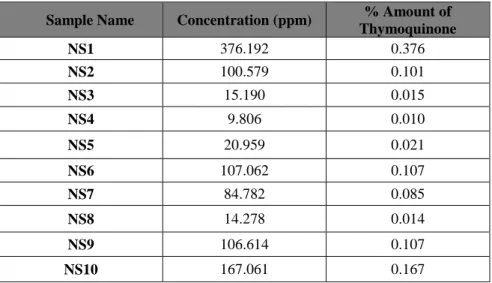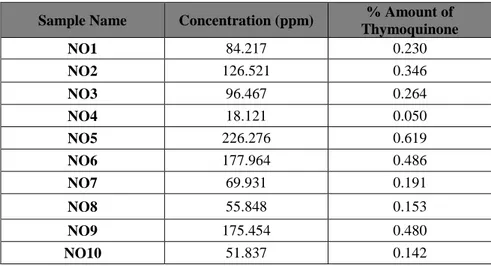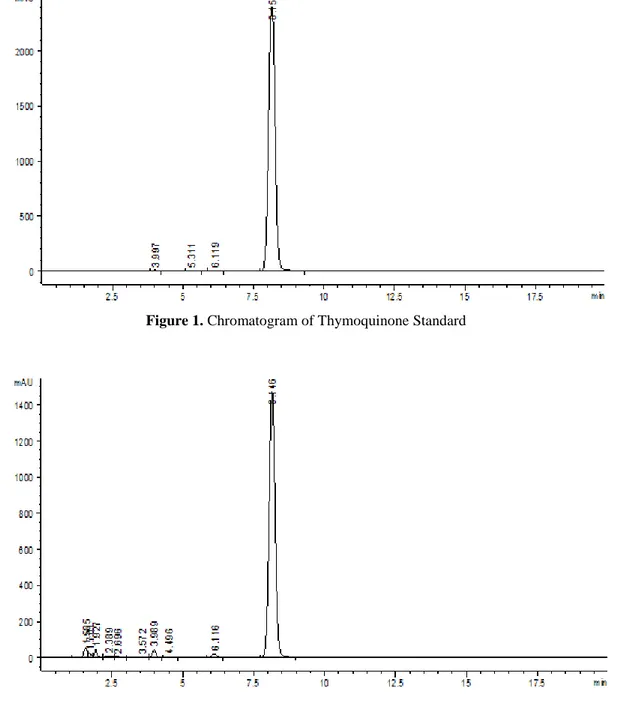ORIGINAL ARTICLE / ÖZGÜN MAKALE
QUANTITATIVE ANALYSIS OF THYMOQUINONE IN NIGELLA
SATIVA L. (BLACK CUMIN) SEEDS AND COMMERCIAL SEED OILS
AND SEED OIL CAPSULES FROM TURKEY
TÜRKİYE’DE YETİŞEN NIGELLA SATIVA L. (ÇÖREK OTU)
TOHUMLARI, TİCARİ TOHUM YAĞLARI VE TOHUM YAĞI
KAPSÜLLERİNDEKİ TİMOKİNONUN KANTİTATİF ANALİZİ
Selin ISIK
1, Murat KARTAL
2, Sinem ASLAN ERDEM
2*1
Ankara University, Institute of Biotechnology, 06100, Tandogan, Ankara
2
Ankara University, Faculty of Pharmacy, Department of Pharmacognosy, 06100, Tandogan,
Ankara
SUMMARY
Medicinally and economically important plant Nigella sativa L., popularly known as çörek otu in Turkey, is cultivated in many parts of Turkey. The most important component of its oil is thymoquinone. Nigella sativa is used in alternative medicine to treat cancer, rheumatism, headaches, and many diseases for thousands of years. In this study, 10 different seed and seed oil samples that have been supplied from local markets in Ankara, were investigated for their thymoquinone contents by HPLC.
Keywords: black cumin; HPLC; Nigella sativa; thymoquinone
ÖZET
Tıbbi ve ekonomik olarak oldukça büyük bir öneme sahip olan ve Türkiye’de çörek otu olarak bilinen Nigella sativa, Türkiye’nin çeşitli bölgelerinde yetiştirilmektedir. Yağının en önemli bileşiği timokinondur. Nigella sativa alternatif tıpta kanser, romatizma, başağrısı ve daha birçok hastalığa karşı binlerce yıldır kullanılmaktadır. Bu çalışmada; Ankara’da bulunan aktarlardan temin edilmiş 10 farklı çörekotu tohumu ve yağı, içerdikleri timokinon miktarlarına göre yüksek performanslı sıvı kromatografisi (HPLC) ile incelenmiştir.
Anahtar kelimeler: çörek otu; HPLC; Nigella sativa, timokinon
* Corresponding Author / Sorumlu Yazar:
Sinem ASLAN ERDEM
e-mail: saslan@pharmacy.ankara.edu.tr
INTRODUCTION
Medicinal plants have been an extensive source of therapeutic agents since ancient times for healing human diseases. Nigella sativa L., belonging to Ranunculaceae, is used as a natural remedy against to a number of illnesses and conditions such as asthma, hypertension, diabetes, inflammation, cough, bronchitis, headache, eczema, fever, dizziness and influenza, for over 2000 years. It is a spicy plant and refined in various parts of the world. The seeds are known as “black cumin” or “black caraway”, likewise “çörek otu” in Turkey and traditionally been used in the Indian sub-continent, Arabian countries, Middle Eastern, and Far Eastern Countries both as spice and natural remedy. In Turkey, it is cultivated in Afyon, Burdur and Isparta regions. It is an annual plant and grows up to 15– 30 cm, branched, more or less furry with finely divided, linear (but not thread-like) leaves. The flowers are delicate, and usually white coloured, with five petals; the seeds are three-sided and black [1-3]. The seeds and the oil are believed to be carminative, diuretic, lactagoge and vermifuge [4].
Pharmacologically, active constituents of seed oils are thymoquinone, dithymoquinone, thymohydroquinone and thymol [5].
The seeds and/or oils of Nigella are also used in foods as spice and seasoning. According to the Islamic belief; the ‘black seed’, is accepted as a panacea (universal cure) i.e. a remedy for all ailments, but cannot prevent ageing or death in Arabic countries s well [6].
The chemical composition of N. sativa seeds was reported for the first time in 1880, and it is found to be composed of oils, proteins, carbohydrates, fibers, ashes, moisturizers, etc. The fixed oil component of N. sativa (36–38%) mostly consisted of linoleic (50–60%), oleic (20–23.4%), palmitic (12.5%), dihomolinoleic (10%), and eicosadienoic (3%) acids as well as arachidonic, stearic, and myristic acids; betasitosterol; cycloeucalenol; cycloartenol; sterolesters; and sterol glucosides with some other minor lipid constituents such as methylnonadeca-15,17-dienoate, pentylhexadec-12-enoate, and pentylpentadec-11-enoate. Their multifunctional preventive and relieving effects have been associated to significant constituents such as nigellicine, nigellidine, thymoquinone (TQ), dithymoquinone, thymol, and carvacrol [7].
Screening of vitamin content of the seeds indicated that N. sativa seeds contain significant amounts of vitamins B1, B6 and niacin, additionally vitamin B2 and folic acid relatively in smaller amounts. The results are summarized at Table 1 [8].
Table 1. Vitamin composition of N. sativa L. seeds [8]
Vitamin Found (µg per 100 g) RDA*(%)
B1 (Thiamin) 831 + 11.36 55.3
B2 (Riboflavin) 63 + 3.32 3-5
B6 (Pyridoxine) 789 + 8.89 35.9
PP (Niacin) 6311 + 16.52 33.2
Folic acid 42 + 4.58 10
*Recommended Dietary Allowances (Anon., 1980).
N. sativa seeds contain fixed oil, saponins, alkaloids, proteins and essential oil. Thymoquinone is
the most prominent constituent in N. sativa and there has been, 406 posted research reports about TQ on the "PubMed" database since 1960. Beside the popularity of the Thymoquinone, it is also the main responsible constituent of the hepatoprotective, the anti-inflammatory and the anti-cancer and antitumor effects of Nigella’s seed essential oil [9].
The results of a study which investigate the hepatoprotective effects of TQ against acetaminophen-induced hepatotoxicity on Wistar albino rats shows that, the levels of aspartat aminotransferase (AST), oxidized glutathione (GSSG), serum alanine aminotransferase (ALT) and superoxide dismutase (SOD) activity were found to be lower compared to that of rats treated without thymoquinone [10].
According to Al Wafai [11], N. sativa and TQ treatment is responsible of the suppression of COX-2 enzyme’s expression in the pancreatic tissue of streptozotocin (STZ)-induced diabetic rats.
It was shown that essential oil and methanolic extract of N. sativa and its active principle, thymoquinone, displays potent antileishmanial effects against L. tropica and L. infantum (genus of trypanosomes) species in the in vitro model [12].
In a recent study, immunohistochemical analysis confirmed that thymoquinone significantly decreased Cd-induced over expression of nuclear factor-κB in renal tissue. Moreover, thymoquinone treatment resulted decrease of the in apoptotic cell numbers. Thymoquinone considerably suppressed lipid peroxidation, atoned deficits in the antioxidant defenses (reduced superoxide dismutase, glutathione peroxidase and catalase activities) in renal tissue induced by Cd administration. These results suggest that thymoquinone’s antioxidant and anti-apoptotic properties would be more advantageous for achieving maximum effects in nephrotoxicity induced by Cd [13].
In this study, all samples (seeds, seed oils and seed oil capsules) have different trademarks that supplied from local markets in Ankara and they were investigated for their thymoquinone contents by HPLC.
MATERIALS AND METHODS
Chemicals and Materials: HPLC grade methanol and 2-propanol (Fisher Scientific, Pittsburgh,
PA) were used. Millipore filtered water was obtained by passing distilled water through a Milli-Q system (Millipore Corp., Milford, MA). Thymoquinone (Sigma, St. Louis, MO) was purchased and dissolved in HPLC grade methanol for the analysis.
Samples: Samples were supplied from local markets in Ankara. Each seeds, seed oils and seed oil
capsules have a different brand. The seeds were coded as NS 1 to 10, the seed oils were coded as NO 1 to 10 and the seed oil capsules were coded as NOC 1 to 10.
Seed extraction: 5 g seeds were powdered and stirred with 200 ml methanol for 2 hours than
filtered and evaporated by using rotavapor. The residue was solved gradually with methanol and completed to 50 ml with methanol.
Oil extraction: 20 µL black cummin oils of both oil products and capsules were filtered from
Agilent ZORBAX SPE C18 (EC) cartridges (Agilent corporation, USA.) with 2x400µL methanol.
HPLC Quantification: For the quantitative analysis; standart thymoquinone solutions were
prepared at 0.5, 1, 5, 15, 25, 50, 100, 250, 500 and 750 ppm concentrations. Areas of these concentrations were used for the calibration.
HPLC Conditions: Samples were analysed with Agilent Technologies 1200 series high pressure
liquid chromatography (HPLC), including a binary pump, a vacuum degasser, an autosampler and a diode array dedector. Chromatographic separations were performed on Eclipse XDB-C18 column (150 mm x 4.6 mm, 5µm). Isocratic mobile phase was chosed for as mobile phase; water:methanol:2-propanol (50:45:5) solution was used for separation at a flow rate of 0.9 mL min-1. Analysis time was 28 min and the detection wavelength was set at 254 nm for thymoquinone. Identification on thymoquinone was made by comparing the retention times and UV spectras of the peaks of pure standards. The injection volume was 10 µL for each sample and standard solutions. All the calculations concerning the quantitative analysis were performed with external standardization by measurement of peak areas. Limit of detection (LOD) and limit of quantification (LOQ) were established at a standard deviation over slope of 3.3 and 10, respectively.
RESULTS AND DISCUSSION
The HPLC chromotogram obtained from the analysis of the seeds and seed oils, described above showed well resolved peaks with no interference. Chromatograms of the standard and a sample examined are given in Figures 1 and 2 respectively; other chromatograms were not given since they are similar with the sample mentioned below. Thymoquinone was observed in all samples and the quantity
of the thymoquinone found in the seeds, seed oils and seed oil capsules are given in Table 2, Table 3 and Table 4 with both concentrations and percentages, respectively. Calibration equation, lOD and LOQ values are given in Table 5.
Interestingly, all the samples examined were found to contain only thymoquinone in significant amounts, and not the other derivatives such as dithymoquinone and thymohydroquinone. Although the percentages of thymoquinone vary for each sample, oils were found to contain higher amounts of thymoquinone compared to the seeds in general. According to the tables given below, sample NS1 has the highest and sample NS4 has the lowest amounts of thymoquinone. For oil samples; sample NO9 has the highest and sample NO4 has the lowest amounts of thymoquinone. Among the thymoquinone contents of oil capsules, while NOC3 sample has the highest amount of thymoquinone, NOC4 sample has the lowest. When we compare the results of oil samples with Ghoseh`s study [4], it clearly showes that we have similar results related to thymoquinone content.
The source of thymoquinone is not only black cumin. According to Tabosrky’s research [14], there are many other plants which have high amount of thymoquinone, dithymoquinone and thymohyrdoquinone. For the identification of other sources of thymoquinone, dithymoquinone and thymohyrdoquinone; 7 plant families were investigated and it was revelaed that 11 out of 47 plant species also have these components. Results of the study shows that Monarda didyma L. (chemotype 1), Monarda didyma L. (chemotype 2), Monarda media Willd., Monarda menthifolia Graham and
Satureja montana L. also contain thymoquinone, dithymoquinone and thymohyrdoquinone.
Thymoquinone contents in that study found to be similar to to the findings of our study.
Table 2. Concentrations and amounts of thymoquinone in seeds (in mg) Sample Name Concentration (ppm) % Amount of
Thymoquinone NS1 376.192 0.376 NS2 100.579 0.101 NS3 15.190 0.015 NS4 9.806 0.010 NS5 20.959 0.021 NS6 107.062 0.107 NS7 84.782 0.085 NS8 14.278 0.014 NS9 106.614 0.107 NS10 167.061 0.167
Table 3. Concentrations and amounts of thymoquinone in seed oils (in mg) Sample Name Concentration (ppm) % Amount of
Thymoquinone NO1 84.217 0.230 NO2 126.521 0.346 NO3 96.467 0.264 NO4 18.121 0.050 NO5 226.276 0.619 NO6 177.964 0.486 NO7 69.931 0.191 NO8 55.848 0.153 NO9 175.454 0.480 NO10 51.837 0.142
Table 4. Concentrations and amounts of thymoquinone in seed oil capsules (in mg) Sample Name Concentration (ppm) % Amount of
Thymoquinone NOC1 267.707 0.732 NOC2 185.426 0.507 NOC3 740.098 2.023 NOC4 13.459 0.037 NOC5 296.747 0.811 NOC6 37.363 0.102 NOC7 76.780 0.210 NOC8 15.681 0.043 NOC9 94.222 0.258 NOC10 105.649 0.289
Table 5. Calibration equation, limit of detection (LOD) and limit of quantification (LOQ) values
Compound Standard curve r2 LOD (ppm) LOQ (ppm)
Figure 1. Chromatogram of Thymoquinone Standard
Figure 2. Chromatogram of Nigella sativa seed 1 (NS1)
CONCLUSION
In this study, the amount of thymoquinone is determined in black cumin seeds, seed oils and seed oil capsules quantitatively by HPLC. Thymoquinone determination in these three sample types containing Nigella (seeds, seed oils and oil capsules) is the main goal of this investigatation. As far as we were concerned, this is the first study examining and comparing thymoquinone contents of seeds of
Nigella sativa, commercial seed oils and seed oil capsules in Turkey quantitatively. It can be concluded
REFERENCES
1. Gencler–Ozkan, A.M. (2011). Nigella sativa L. in FFD Monografları, Tedavide kullanılan Bitkiler. Demirezer, L.Ö. (Ed.) 2nd edition, MN Medikal & Nobel, pp. 423-431, Ankara.
2. Davis, P.H. (1965-1985). Flora of Turkey and the East Aegean Islands, Edinburg University Pres, 1-9, Edinburg.
3. Houghton, P.J., Zarka, R., Heras, B., Hoult, R.S. (1995). Fixed oil of N. sativa and derived thymoquinone inhibit eicosanoid generation in leucoytes and membrane lipid peroxidation. Planta Med., 61, 33-36.
4. Ghosheh, O.A., Houdi, A.A., Crooks, P.A. (1999). High performance liquid chromatography analysis of the pharmacologically active quinines and related compounds in the oil of the black seed (Nigella sativa). Journal of Pharmaceutical and Biomedical Analysis, 19, 757–762.
5. Bourgou S., Ksouri R., Bellia A., Skandrani I., Falleh H., Marzouk B. (2008). Phenolic composition and biological activities of Tunisian Nigella sativa L. shoots and roots. C. R. Biologies, 331(1), 48-55.
6. Ali B.H., Blunden, G. (2003). Pharmacological and toxicological properties of Nigella sativa. Phytother Res., 17, 299–305.
7. Gholamnezhad, Z., Havakhah, S., Boskabady, H.M. (2016). Preclinical and clinical effects of
Nigella sativa and its constituent, thymoquinone: A review. Journal of Ethnopharmacology, 190,
372-386.
8. Nergiz C. (1993). Otles S. Chemical composition of Nigella sativa L. seeds. Food Chemistry, 48, 259-261.
9. Khander, M., Eckl, P.M. (2014). Thymoquinone: an emerging natural drug with a wide range of medical applications. Iran J Basic Med Sci, 17, 950-957.
10. Aycan, I.O., Tufek, A., Tokgoz, O., Evliyaoglu, O., Firat, U., Kavak, G.O., Turgut, H., Yuksel, M.U. (2014). Thymoquinone treatment against acetaminophen-induced hepatotoxicity in rats. Int J Surg, 12, 213-218.
11. Al Wafai R.J. (2013). Nigella sativa and thymoquinone suppress cyclooxygenase-2 and oxidative stress in pancreatic tissue of streptozotocin-induced diabetic rats. Pancreas, 42, 841-849.
12. Mahmoudvand, H., Tavakoli, R., Sharififar, F., Minaie, K., Ezatpour, B., Jahanbakhsh, S., Sharifi, I. (2014). Leishmanicidal and cytotoxic activities of Nigella sativa and its active principle, thymoquinone. Pharmaceutical Biology., 53(7), 1052-1057.
13. Erboga, M., Kanter, M., Aktas, C., Sener, U., Fidanol Erboga, Z., Bozdemir Donmez, Y., Gurel, A. (2016). Thymoquinone Ameliorates Cadmium-Induced Nephrotoxicity, Apoptosis, and Oxidative Stress in Rats is Based on its Anti-Apoptotic and Anti-Oxidant Properties. Biological Trace Element Research, 170(1), 165-172.
14. Taborsky, J., Kunt, M., Kloucek, P., Lachman. J., Zeleny, V., Kokoska, L. (2012). Identification of potantial sources of thymoquinone and related compounds in Asteraceae, Cupressaceae, Lamiaceae and Ranunculaceae families. Central European Journal of Chemistry, 10(6), 1899-1906
![Table 1. Vitamin composition of N. sativa L. seeds [8]](https://thumb-eu.123doks.com/thumbv2/9libnet/3868169.38565/3.892.110.726.156.324/table-vitamin-composition-n-sativa-l-seeds.webp)


